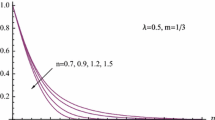Abstract
Theoretical investigation has been carried out of laminar thermal boundary layer response to harmonic oscillations in velocity associated with a progressive wave imposed on a steady free stream velocity and convected in the free stream direction. Series solutions are derived both to velocity and temperature field and the resulting equations are solved numerically. The functions affecting the temperature field are shown graphically for different values of Prandtl number. It is observed that there is more reduction in the rate of heat transfer for P r<1 and a rise in the rate of heat transfer for P r>1 due to the presence of oscillatory free-stream.
Similar content being viewed by others
Abbreviations
- u, v :
-
velocity components in the x and y direction
- x, y :
-
Cartesian coordinate axes
- t :
-
time
- U, U 0 :
-
instantaneous value of and mean free stream velocity
- ρ :
-
density of fluid
- ν :
-
kinematic viscosity
- T, T w, T∞ :
-
temperature of the fluid, wall and free stream fluid
- c p :
-
specific heat at constant pressure
- α :
-
thermal diffusivity
- λ :
-
amplitude of free stream velocity
- ω :
-
frequency
- θ p :
-
non-dimensional temperature (T−T ∞/T w−T ∞)
- P r :
-
Prandtl number (μc p/K)
- E c :
-
Eckert number (U 20 /c p(T w−T ∞))
- β :
-
a parameter (\((\sqrt {\omega x/U_0 } )\))
- δ 0 :
-
boundary layer thickness of the oscillation of a harmonic oscillation of frequency θ(\((\sqrt {2v/\omega } )\))
- δ :
-
ordinary boundary layer thickness (\((\sqrt {vx/\bar U} )\))
- Ū :
-
time-averaged, time-independent external velocity
- A, B, C, D, E, K, L, M, N, P :
-
functions used in expansion for u and θ
- Nu :
-
Nusselt number (hx/k)
- Δθ :
-
T w−% MathType!MTEF!2!1!+-% feaafiart1ev1aaatCvAUfeBSjuyZL2yd9gzLbvyNv2CaerbuLwBLn% hiov2DGi1BTfMBaeXatLxBI9gBaerbd9wDYLwzYbItLDharqqtubsr% 4rNCHbGeaGqiVu0Je9sqqrpepC0xbbL8V4rqqrFfpeea0Jc9yq-Jc9% vqaqpepm0xbba9pwe9Q8fs0-yqaqpepae9pg0FirpepGe9fr-xfr-x% frpeWZqaaeaabiGaciaacaqabeaadaqaaqaaaOqaaiaacIcadaGcaa% qaaiaadAhacaWG4bGaai4laiqadwfagaqeaaWcbeaakiaacMcaaaa!3CA6!\[(\sqrt {vx/\bar U} )\]
- k :
-
thermal conductivity
References
Lighthill, M. J., Proc. Roy. Soc. A224 (1954) 1.
Lin, C. C., Proc. 9th Int. Congress Appl. Mech. 4 (1957) 155.
Hill, P. G. and A. H. Stenning, Trans. ASME, J. Basic Eng., 82D (1960) 593.
Kestin, J., P. F. Maeder, and H. E. Wang, Appl. Sci. Res. A10 (1961) 1.
Patel, M. H., Proc. Roy. Soc. A327 (1975) 99.
Schlichting, H., Boundary layer theory, McGraw Hill, 1960, p. 234 and 331.
Author information
Authors and Affiliations
Rights and permissions
About this article
Cite this article
Takhar, H.S., Soundalgekar, V.M. Effects of viscous dissipation on heat transfer in an oscillating flow past a flat plate. Appl. Sci. Res. 33, 101–111 (1977). https://doi.org/10.1007/BF00383195
Received:
Revised:
Issue Date:
DOI: https://doi.org/10.1007/BF00383195




